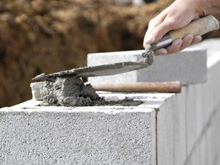Masonry Work Tampa
Masonry Work Tampa – Beautiful Stone and Brick Masonry Specialists
Complete Masonry Work Services
 Masonry work refers to any structure that has been built by binding individual materials together with mortar, a paste made of cement, water, and sand. Various materials including brick, stone, and marble can be used in order to create masonry work. There are three main types of masonry that are used for different applications depending upon the structure that is to be built.
Masonry work refers to any structure that has been built by binding individual materials together with mortar, a paste made of cement, water, and sand. Various materials including brick, stone, and marble can be used in order to create masonry work. There are three main types of masonry that are used for different applications depending upon the structure that is to be built.
Veneer masonry is constructed using numerous pieces that fit around another structure. Often, this type of masonry work is produced for aesthetic reasons. Since the bricks that are used to create veneer masonry aren’t usually waterproof, the structure that supports this type of masonry work must be able to withstand all elements. Homes that have brick surfaces are often constructed through veneer masonry.
In contrast, solid masonry does not require any kind of supportive structure. Walls that are made from brick and stone are the result of this type of masonry work. While economical and aesthetically appealing, solid masonry does not always withstand harsh weather conditions. Frequently, walls created using this kind of masonry are destroyed during earthquakes.
Brickwork is the most popular type of masonry, since this type of structure is both solid and appealing. Brickwork is created when more than two layers of bricks form a horizontal pattern. The outcome of brick masonry largely depends upon the type of brick selected for the job. While some bricks tend to take on a modern appearance, other bricks have a traditional look to them. This type of masonry is perfect for any wall or building that is meant to withstand the test of time.
In addition to the three main types of masonry work mentioned above, a fourth kind of masonry also exists. Serpentine masonry is a term that has been given to masonry projects that do not form a straight line. Instead, serpentine masonry follows a winding path, which makes it far more resistant to wear and tear. This type of wall can also be referred to as a “crinkle-crankle” wall.
Stonemasonry is the craft of shaping rough pieces of rock into accurate geometrical shapes, mostly simple, but some of considerable complexity, and then arranging the resulting stones, often together with mortar, to form structures.
- Quarrymen split the rock, and extract the resulting blocks of stone from the ground.
- Sawyers cut these rough blocks into cubes, to required size with diamond-tipped saws.
- Banker masons are workshop based, and specialize in carving stones into intricate geometrical shapes required by a building’s design. They can produce anything from stones with simple chamfers to tracery windows, detailed mouldings and the more classical architectural building masonry. When working a stone from a sawn block, the mason ensures that the stone is bedded in the right way, so the finished work sits in the building in the same orientation as it was formed on the ground. The basic tools, methods and skills of the banker mason have existed as a trade for thousands of years.
- Carvers cross the line from craft to art, and use their artistic ability to carve stone into foliage, figures, animals or abstract designs.
- Fixer masons specialize in the fixing of stones onto buildings, using lifting tackle, and traditional lime mortars and grouts. Sometimes modern cements, mastics and epoxy resins are used, usually on specialist applications such as stone cladding. Metal fixings, from simple dowels and cramps to specialised single application fixings, are also used. The precise tolerances necessary make this a highly skilled job.
- Memorial masons or monumental masons carve gravestones and inscriptions.
The modern stonemason undergoes comprehensive training, both in the classroom and in the working environment. Hands-on skill is complimented by intimate knowledge of each stone type, its application and best uses, and how to work and fix each stone in place. The mason may be skilled and competent to carry out one or all of the various branches of stonemasonry. In some areas the trend is towards specialization, in other areas towards adaptability. – Source Wikipedia.
